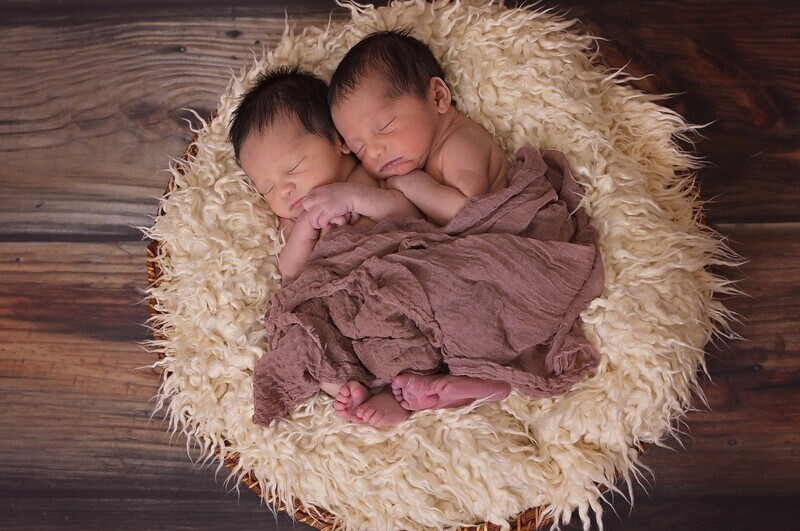hankyoreh
Links to other country sites 다른 나라 사이트 링크
Twin births at historic high, study reveals

When the world’s first “test tube baby” was born through in vitro fertilization (IVF) in 1978, it was taken as a blessing and a hopeful development by infertile couples who had struggled with natural pregnancy.
In vitro fertilization is a technique in which an egg is fertilized with sperm in a laboratory setting (“in vitro” means “in glass,” as in a test tube). The resulting embryo is then placed into the uterus.
During the four decades since that first test tube baby, the technique has enabled more than 8 million babies to be born. But it has also given rise to another phenomenon.
The steps taken to increase the pregnancy success rate in IVF have led to a higher frequency of twins being born.
It’s not that unusual to encounter twins these days. There are even some countries in which the number of twins is increasing, despite a broader decline in childbirth.
One of those countries is South Korea. The number of newborns has fallen by more than half over the past two decades, from 630,000 in 2000 to 300,000 in 2019. But the number of twins has increased by 30%, from 10,700 to 14,000, over the same period.
Analysts say that the boom in twins is reaching a historic peak, in counterpoint to global trends of declining childbirth and societal aging.
According to a paper published Friday in Human Reproduction, an academic journal produced by the European Society of Human Reproduction and Embryology, the global twin birth rate has risen from 0.9% to 1.2%, or more than 30%, over the past thirty years. The paper, prepared by an international research team led by Oxford University Professor Christiaan Monden, came to this conclusion after analyzing statistics compiled from 1980 to 2015 in 165 different countries.
In terms of the number of babies, rather than the number of deliveries, twins account for 2.4% of the total. In other words, one of every 42 babies born on the planet is a twin.
The number of twin deliveries each year has increased 43% in three decades, from a yearly average of 1,165,000 deliveries in 1980-1985 to 1,663,000 in 2010-2015. But the total number of annual deliveries has only increased by about 8% in the same period, from 128,827,000 to 138,590,000.
The research team found that the twin delivery rate has increased in most countries since the 1980s. In South Korea, the rate tripled from 0.5% in the early 1980s to 1.54% in the early 2010s. That’s an exceedingly steep rise, considering that Korea’s first test tube baby was born in 1985.
According to childbirth figures released each year by Statistics Korea, twins accounted for 4.6% of all children born in the country in 2019.
Most of this increase is made up of fraternal twins. That comes from implanting two or more fertilized eggs that have been extracted from the ovary following controlled ovarian hyperstimulation, in a bid to increase the pregnancy success rate in infertile couples.
One concern about IVF is that twins run a greater risk of being born prematurely or with a low birth weight. For that reason, infertility clinics in the UK are only allowed to transfer a single embryo to the womb during IVF.
In 2015, South Korea lowered the maximum number of embryos that can be transferred to the womb in IVF from five to three.
The research team predicts that, as a result of such changes, the twin delivery rate in advanced economies will decline in the decade following its 2010-2015 peak.
By Kwak No-pil, senior staff writer
Please direct comments or questions to [english@hani.co.kr]

Editorial・opinion
![[Editorial] Korea must respond firmly to Japan’s attempt to usurp Line [Editorial] Korea must respond firmly to Japan’s attempt to usurp Line](https://flexible.img.hani.co.kr/flexible/normal/500/300/imgdb/original/2024/0514/2317156736305813.jpg) [Editorial] Korea must respond firmly to Japan’s attempt to usurp Line
[Editorial] Korea must respond firmly to Japan’s attempt to usurp Line![[Editorial] Transfers of prosecutors investigating Korea’s first lady send chilling message [Editorial] Transfers of prosecutors investigating Korea’s first lady send chilling message](https://flexible.img.hani.co.kr/flexible/normal/500/300/imgdb/original/2024/0514/7917156741888668.jpg) [Editorial] Transfers of prosecutors investigating Korea’s first lady send chilling message
[Editorial] Transfers of prosecutors investigating Korea’s first lady send chilling message- [Column] Will Seoul’s ties with Moscow really recover on their own?
- [Column] Samsung’s ‘lost decade’ and Lee Jae-yong’s mismatched chopsticks
- [Correspondent’s column] The real reason the US is worried about Chinese ‘overcapacity’
- [Editorial] Yoon’s gesture at communication only highlights his reluctance to change
- [Editorial] Perilous stakes of Trump’s rhetoric around US troop pullout from Korea
- [Guest essay] Preventing Korean Peninsula from becoming front line of new cold war
- [Column] The state is back — but is it in business?
- [Column] Life on our Trisolaris
Most viewed articles
- 1Ado over Line stokes anti-Japanese sentiment in Korea, discontent among Naver employees
- 2[Column] Samsung’s ‘lost decade’ and Lee Jae-yong’s mismatched chopsticks
- 3Korean opposition decries Line affair as price of Yoon’s ‘degrading’ diplomacy toward Japan
- 4US has always pulled troops from Korea unilaterally — is Yoon prepared for it to happen again?
- 5Korean auto industry on edge after US hints at ban on Chinese tech in connected cars
- 6[Editorial] Yoon’s gesture at communication only highlights his reluctance to change
- 7[Correspondent’s column] The real reason the US is worried about Chinese ‘overcapacity’
- 8[Column] Will Seoul’s ties with Moscow really recover on their own?
- 9[Photo] Korean students protest US complicity in Israel’s war outside US Embassy
- 101 in 3 S. Korean security experts support nuclear armament, CSIS finds